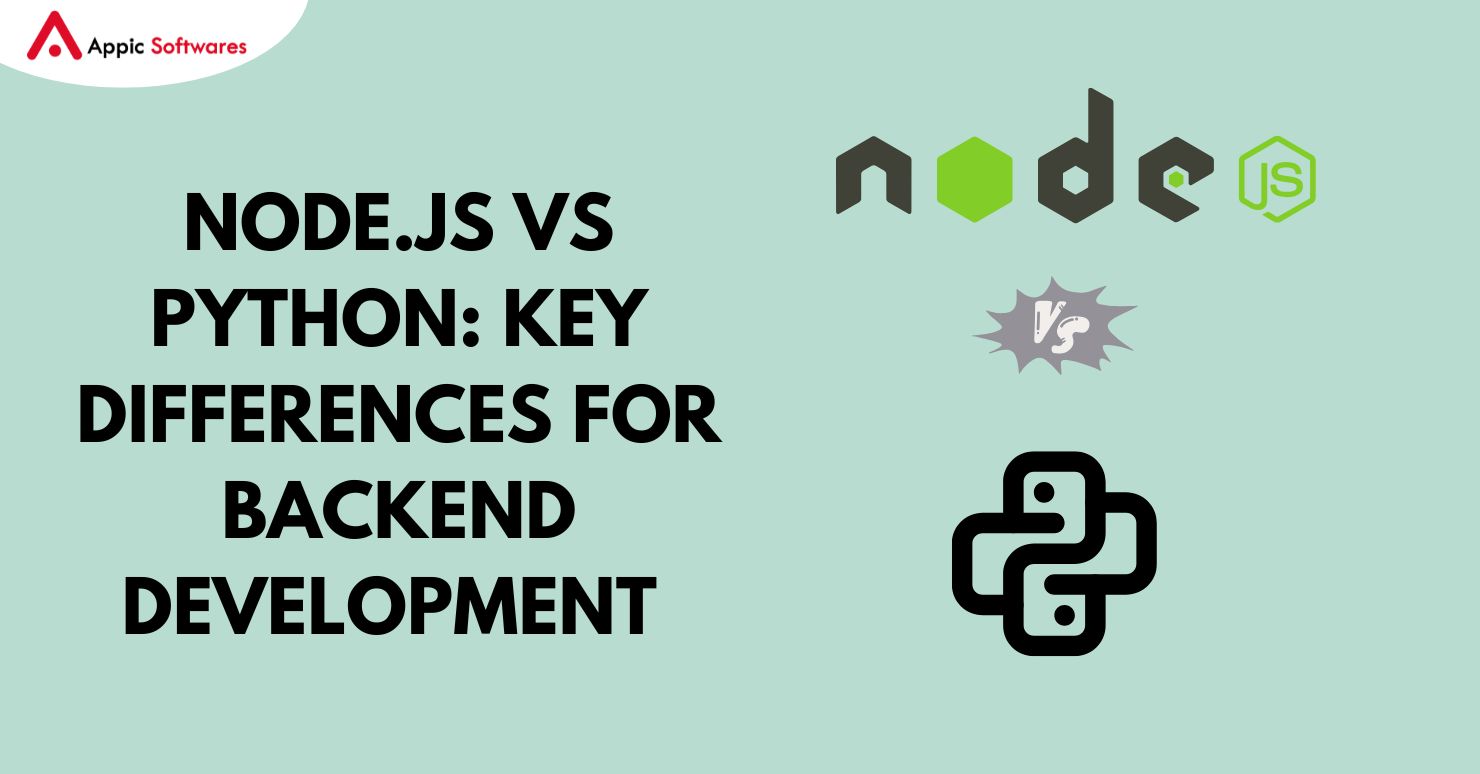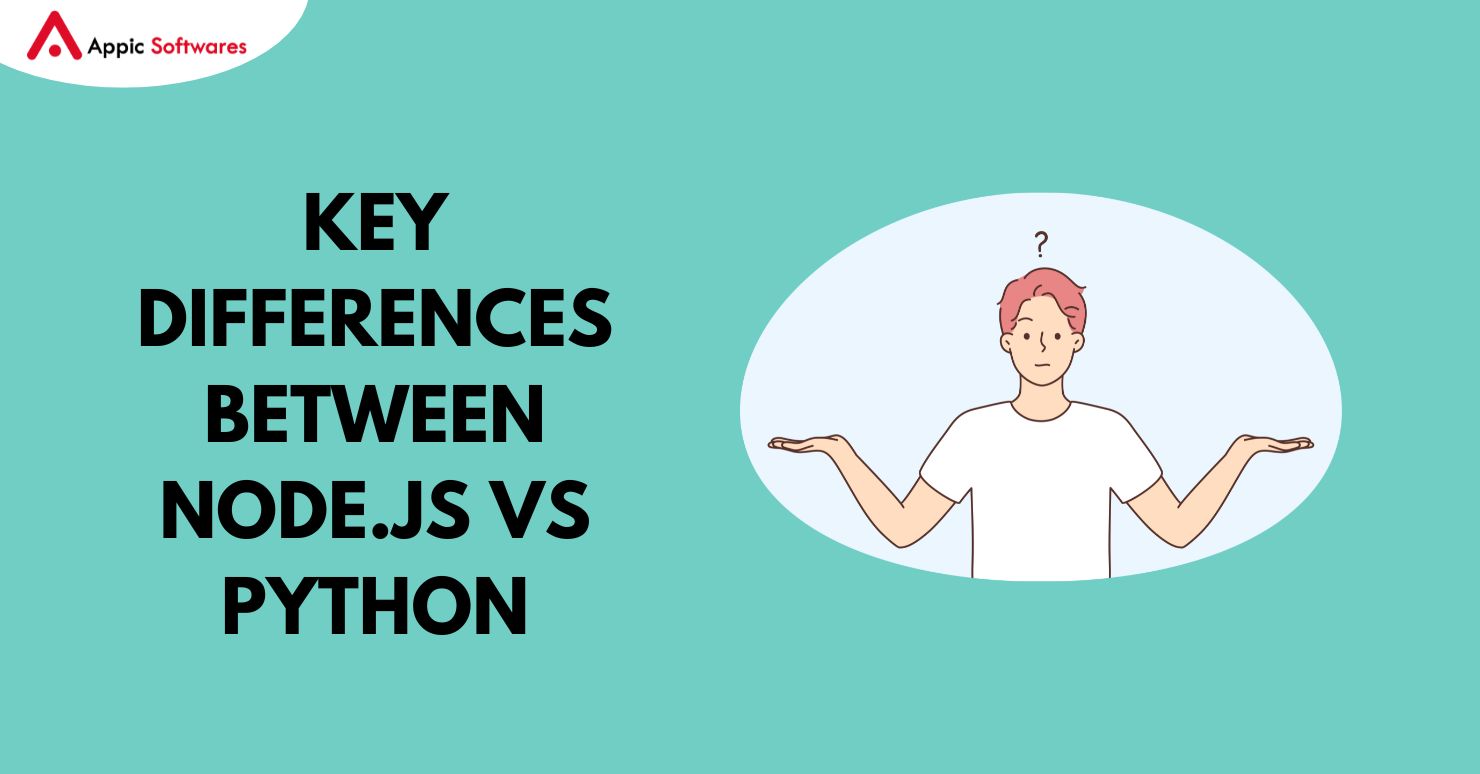
According to a 2024 Stack Overflow Developer Survey, JavaScript remains the most commonly used programming language for the 12th year in a row, while Python holds the second spot as one of the most loved languages globally. Moreover, a 2024 JetBrains Developer Ecosystem report shows that Node.js is the most popular JavaScript runtime for backend development, and Python is the top choice for data science and automation.
Backend development usually means the right choice of server-side tools. The comparison of Node.js vs Python is often a popular one, as both these technologies are well-known back-end applications. Node.js is a JavaScript runtime environment that operates on the Google V8 platform, and Python is a high-level language that is known for readability. Node.js came into the picture in 2009 to enable JavaScript scripting on servers. Python, on the other hand, is old (since 1991) and capable of much (including web and data processing work). The developers can use the difference between the two to decide which tool to apply in a specific project. In this article, we are going to discuss the major differences between Node.js and Python.
What is Node.js?
Node.js can be well characterized as a runtime environment rather than a language. It allows creating JavaScript applications in a browser. As most browsers are already supporting JavaScript in web pages, Node.js was designed to extend it such that the same language can be used on the server side as well. Node.js is based on the V8 engine (the same engine that Google Chrome uses) and translates JavaScript into machine code live. This Just-In-Time (JIT) compilation translates into the fact that the Node.js code tends to become very fast.
Also, running code outside the browser means Node.js can do things (like open network sockets) that browsers cannot. This makes the node boot camp faster in practice for many web tasks. Node.js is event-driven and non-blocking. This means it can start long tasks (like reading a file) and immediately go back to listening for other events. When a task finishes, Node.js picks up the callback and resumes that work. This design lets a single Node.js server handle many connections at the same time. Each connection emits events, and Node.js listens for those events to run callback functions.
If you’re curious about the platform’s latest advancements, learn what’s new in Node.js 21.
What is Python
Python web development is known for being clean, readable, and highly productive. Python supports multiple programming paradigms and is used extensively across various domains, from web development and automation to AI and machine learning.
Unlike Node.js, Python code is interpreted line by line. When you run a Python program, the interpreter executes each instruction in order. There is no ahead-of-time compilation to machine code by default, so each line of code has some overhead when it runs. For tasks that involve a lot of computation or I/O, this means Python might take longer to finish the same work than Node.js, which compiles some code as it goes.
Python’s Global Interpreter Lock (GIL) is important to understand. The GIL is a mutex that allows only one native thread to execute Python bytecode at a time. In simple terms, even if a Python program starts multiple threads, only one thread can run Python for back-end development code at any given moment. Each thread has to wait its turn. This makes multithreading CPU-bound work ineffective in standard Python. For a Python web server, the common workaround is to run multiple processes (each with its own Python interpreter) or use asynchronous libraries like asyncio.
To stay updated with language evolution, you can explore the latest Python trends to know.
Key Differences Between Node.js vs Python

Performance and Speed
When comparing Node vs Python performance, one key factor is how each handles I/O and CPU work. Node.js often outperforms Python for typical web workloads because it uses the V8 engine with JIT compilation. Node.js quickly converts JavaScript to fast machine code and uses non-blocking I/O. This means that operations like reading from a database or file do not freeze the server; Node.js can move on to other tasks in the meantime.
Python, on the other hand, runs code sequentially. Its interpreter must process each instruction, and the GIL prevents multiple Python threads from running at once. Many Python web servers handle multiple requests by starting multiple processes or using asynchronous frameworks. Each process still does one thing at a time. For CPU-heavy tasks, Python can use multiple processes to use more cores, but this also uses more memory and overhead. In practice, a Node.js server often responds to web requests faster than a Python server with the same logic.
For instance, if you benchmark a simple web API, Node.js usually returns responses faster than a Python-based server with identical functionality. Node.js benefits from running code outside the browser and from an event-driven loop. Python’s simplicity comes with some speed cost, but it can still handle a lot of traffic if set up well (for example, with optimized libraries or multiple workers). Here are some key points on based on key performance:
-
Node.js:
Uses the V8 engine with JIT compilation. Its single-threaded event loop handles many I/O operations concurrently. Node.js often achieves higher throughput (more operations per second) in web servers and real-time applications.
-
Python:
Runs code line-by-line in an interpreter. The GIL (Global Interpreter Lock) prevents parallel threads. Python backends typically run multiple processes or use async frameworks to scale. Python is often slower than Node.js for raw request throughput, but it has strong libraries for specialized tasks.
Bonus read: Django Web Development With Python: Cost, Process, & More
Concurrency and Scalability
Concurrency means handling many tasks at the same time. Scalability means handling an increasing load (more users or data). Node.js and Python take different approaches to these challenges. Node.js handles concurrency with one main thread and an event loop. When something is waiting (like disk I/O), Node.js does not sit idle. Instead, it registers a callback and moves on. Because of this, a single Node.js process can manage thousands of simultaneous connections without much slowdown. This makes Node.js very scalable for I/O-bound workloads.
In practice, Node.js applications are often built as small microservices. You can run multiple instances of these services on different machines or use clustering to run them on multiple CPU cores in one server. Python’s standard model is more sequential. Due to the GIL, a single Python process won’t run two requests in parallel. To handle more traffic, Python web servers usually start multiple worker processes (for example, using Gunicorn or uWSGI). Each process can handle one request at a time. Adding more processes or machines lets Python scale, but it often uses more memory and management. Python can also use async libraries (asyncio, aiohttp) to improve concurrency, but these still run in one main thread per process.
Key Points on Concurrency & Scalability:
Node.js:
- Handles thousands of connections with one event-driven thread.
- Easy to scale horizontally (add more instances) or use clustering to utilize multiple CPU cores.
- If performance and concurrency are top priorities, many businesses prefer to hire Node.js developers in Saudi Arabia for their backend needs.
Python:
- Uses multiple processes or async libraries for concurrency.
- Each process handles tasks sequentially due to the GIL.
- Scaling often means adding more worker processes or servers.
You may like reading: How Much Does It Cost To Develop A Django React App?
Ecosystem and Libraries
Both Node.js and Python have large ecosystems of libraries and frameworks, but they serve different focuses. Node.js uses NPM (Node Package Manager). It has a vast number of packages (over 350,000) for tasks like web servers, networking, utilities, and tools. Many of these packages support web development. For example, Express.js is a popular framework for building APIs, and Socket.io enables real-time communication (like chat). Because JavaScript is so common on the web, Node.js libraries also integrate easily with front-end tools and frameworks.
Node.js frameworks like Express or Koa simplify creating API endpoints and services quickly. Python’s libraries are available through PyPI and pip. Python excels in areas like data science, machine learning, and scripting. It has web development libraries (such as Django and Flask) but also an immense collection for data analysis and scientific computing. Python’s standard library itself is very rich, and many third-party packages come with thorough documentation. For example, NumPy and Pandas help handle data, and TensorFlow or scikit-learn help with AI models.
In practice, if a project needs heavy data processing or machine learning, Python’s ecosystem is a big plus. If a project is mainly about web APIs, networking, or real-time events, Node.js’s ecosystem has many specialized modules. Both ecosystems can handle common backend needs like databases, caching, and REST APIs. The main difference is the style of packages (NPM for Node.js, PyPI for Python) and the problems they each target best.
Ecosystem Features:
Node.js (npm):
- Over 350k packages mainly for web, networking, and full-stack JavaScript development.
- Strong support for I/O, real-time, and integrating with front-end tech.
Python (PyPI):
- Vast collection covering web frameworks, data analysis, and scientific tools.
- Known for well-written documentation and stable releases.
- Learn more about available options in Python frameworks.
Typical Use Cases
Because Node.js and Python have different strengths, they often serve different needs:
-
Node.js:
Often chosen for high-concurrency applications. Real-time apps (chat servers, live dashboards, multiplayer games) use Node.js because it handles many simultaneous events well. Node.js is also good for APIs, microservices, and streaming data services. If an application needs many users updating data quickly, Node.js is a natural fit.
-
Python:
Often chosen for data-driven or computation-heavy applications. Data analysis, machine learning systems, and scientific applications use Python because of its data libraries. Python is also widely used for web backends when rapid development is needed; frameworks like Django and Flask let developers build robust web services quickly. Tasks like automation scripts, web scraping, or batch processing frequently use Python.
In many real-world systems, teams use both. For example, a company might use Node.js for its real-time web API and use Python for background data processing. The right choice depends on the project: Node.js excels for I/O-heavy, event-driven tasks, while Python excels for computational and data-oriented tasks.
Learning Curve and Developer Productivity
Both Node.js and Python are considered relatively easy to learn, but they come from different backgrounds.
-
Python’s Beginner-Friendly Syntax
Python often feels approachable for new developers because its syntax relies on indentation and reads much like everyday language, making code easy to understand and write. A few lines of code in Flask or Django can spin up a functioning server, which gives beginners a quick sense of accomplishment and less to remember. Error messages in Python tend to point directly to the problem, and countless tutorials guide learners through their first programs, helping Python feel natural from the start.
-
Asynchronous Programming in Node.js
Node.js builds on JavaScript, so someone already comfortable with front-end code will recognize much of its syntax and patterns. The key new idea in Node.js is handling tasks asynchronously, using callbacks, promises, or async/await. At first, thinking in terms of events where the code registers a function to run later can seem odd, but mastering that model lets developers write back-end services that scale smoothly under heavy traffic.
-
Productivity and Ecosystem Tools
Both languages shine with strong package managers and frameworks that boost productivity. In Python, pip installs libraries like Django or Flask to handle web requests with minimal setup, often resulting in fewer lines of code for common tasks. Node.js uses npm to pull in Express or other middleware that speeds up server construction, and because JavaScript spans both front-end and back-end, full-stack teams spend less time context-switching between languages. Each environment offers solid debugging and testing tools, so developers spend more time building features and less time chasing errors.
-
Choosing Based on Your Background
If you’re brand new to programming, Python’s straightforward style and clear error reporting may help you learn core concepts without confusion. On the other hand, if you’ve spent time with JavaScript on the client side, adopting Node.js for the server can feel like a natural next step.
FAQs
What makes Node.js faster than Python for web servers?
Node.js uses an event-driven model that lets it start handling a new request without waiting for the previous one to finish, so it can manage many connections at the same time, while Python typically processes each request step by step and relies on multiple processes or async libraries to scale.
Can I combine Node.js and Python in the same backend?
Yes, you can use Node.js for real-time features or API endpoints and call Python services for tasks like data analysis or machine learning. This approach allows you to leverage the best of both ecosystems. For instance, you can hire Node.js developers in India to handle your JavaScript-based backend and integrate Python microservices using HTTP calls or message queues—letting each language play to its strengths.
Final Words
Node.js and Python are both powerful tools for backend development, each with clear advantages. Node.js offers excellent performance for I/O-bound tasks due to its non-blocking, event-driven design and fast V8 engine. It is particularly well-suited for real-time applications, high-concurrency servers, and situations where using JavaScript on both client and server is helpful. Python offers ease of writing code and a rich library ecosystem, making it ideal for data processing, scientific applications, and areas like machine learning. If you are comparing Node.js vs Python for your project, consider what your project needs most.
Whether you’re looking to develop a high-performance real-time app with Node.js or a powerful data-driven platform with Python, Appic Softwares has the right team for you.
Get expert guidance, dedicated developers, and scalable backend solutions — all under one roof.
Contact us today to bring your backend vision to life!









